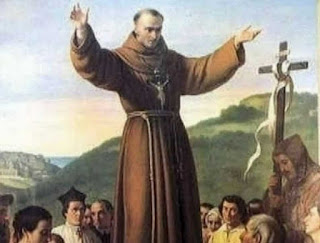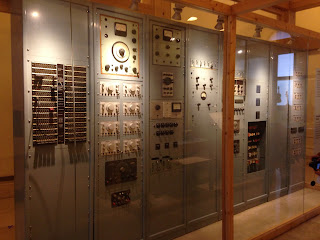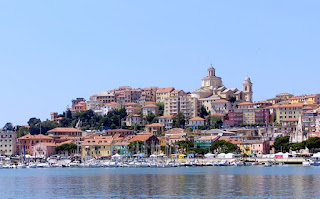Franciscan monk canonized in 1867
| Leonardo survived a life-threatening illness to devote his life to preaching |
Leonardo recovered from a serious illness developed soon after he became a priest and devoted the remaining 43 years of his life to preaching retreats and parish missions throughout Italy.
He was one of the main propagators of the Catholic rite of Via Crucis - the Way of the Cross - and established Stations of the Cross - reconstructions in paintings or sculpture of Christ’s journey to the cross - at more than 500 locations. He also set up numerous ritiri - houses of recollection.
Leonardo was a charismatic preacher who found favour with Popes Clement XII and Benedict XIV, who helped him spread his missions, which began in Tuscany, into central and southern Italy, inspiring religious fervour among the population.
The son of a ship’s captain from Porto Maurizio, the young Paolo was sent to Rome at the age of 13 to live with a wealthy uncle and study at the Jesuit Roman College.
He studied the humanities, rhetoric and philosophy at the Gregorian University and intended to follow a career in medicine. However, while studying he met some Observant Franciscans who lived at the Convent of San Bonaventura al Palatino - known also as the Riformella - and decided to join them.
 |
| Leonardo was a charismatic personality whose preaching persuaded many Italians to devote their lives to faith |
Leonardo completed his studies at San Bonaventura and, after his ordination, he remained there as a professor. It was at that stage that he fell ill, with what has been described as a bleeding ulcer. He was sent back to his home town on the basis that the Ligurian climate might give him a better chance of recovery. Eventually, after being cared for at a monastery of the Franciscan Observants, he was restored to health, although it took four years.
He began to preach in Porto Maurizio and the vicinity before being sent to the monastery of San Miniato near Florence, called Monte alle Croci, shortly after Cosimo III de' Medici had handed it over to the members of the Riformella.
His missions to the people in Tuscany produced startling results, with a large number of conversions, and it was as a means of keeping alive the religious fervour he had awakened that he promoted the Stations of the Cross.
| The Convent of San Bonaventura al Palatino, where Leonardo died, had been a constant in his life |
By 1720, he was taking his celebrated missions into Central and Southern Italy, after which Clement XII and later Benedict XIV asked him to work in Rome.
Benedict XIV, in fact, gave him several difficult diplomatic assignments, in volatile Genoa and Corsica - then part of the Republic of Genoa - Lucca and Spoleto. In all cases, citizens expecting a rich cardinal as the papal emissary were taken aback that a humble, shoeless friar should be the man sent to help resolve their differences.
Leonardo was also at times employed as spiritual director by Maria Clementina Sobieska of Poland, the wife of James Stuart, the Old Pretender.
Amid rumours of his failing health, in November 1751 Benedict XIV recalled Leonardo from Bologna, where he was preaching, to return to Rome. He arrived at the monastery of San Bonaventura al Palatino on the evening of November 26 and died a few hours later.
His remains lie under the high altar there. Pope Pius VI beatified him in 1796 and Pope Pius IX canonised him in 1867. Nowadays, he is the patron saint of those who preach parish missions.
In 1873, one of the first Catholic churches in the United States to be built by Italian immigrants, in Boston, Massachusetts, was named in his honour.
| Mist filling the valleys around Collevecchio, one of many beautiful towns in the Sabine Hills in Lazio |
The Sabine Hills around the city of Rieti, about 80km (50 miles) north of Rome, remains generally an unspoiled rural area, with characteristic rolling hills covered by olive groves and fruit orchards and dotted with medieval hilltop villages and castles. Among the most beautiful of those medieval villages, all of which have impressive defensive walls, ornately decorated renaissance palaces and churches and picturesque piazzas are Toffia, Fara Sabina, Farfa, Bocchignano and Montopoli. The area is famous for its extra virgin olive oil, the first in Italy to receive the DOP denomination (Protected Designation of Origin).
| The shoreline of Porto Maurizio in Liguria, where Leonardo was born Paolo Casanova in 1676 |
Porto Maurizio, where San Leonardo was born, lost its identity somewhat in 1923 when Mussolini created the city of Imperia by combining Porto Maurizio and Oneglia, towns on the Riviera Poniente separated by the Impero river, with several surrounding villages. Imperia’s economy is mainly based on tourism and the food industry, as a producer of olive oil and pasta. Porto Maurizio was originally a Roman settlement, Portus Maurici. Napoleon Bonaparte stopped for a night in Porto Maurizio during the Napoleonic Wars. The town has a classical cathedral, dedicated to San Maurizio, which was built by Gaetano Cantoni and completed in the early 19th century. The Convent of Santa Chiara was first established in 1365.
More reading:
Pope Clement XII and the competition that resulted in the Trevi Fountain
Bendict XIV - the intellectual pope
Luigi Guido Grandi - monk and mathematician
Also on this day:
1856: The death of Sicilian patriot Francesco Bentivegna
1947: The birth of singer Gigliola Cinquetti
1948: The birth of Giuliana Sgrena, war reporter
Home



